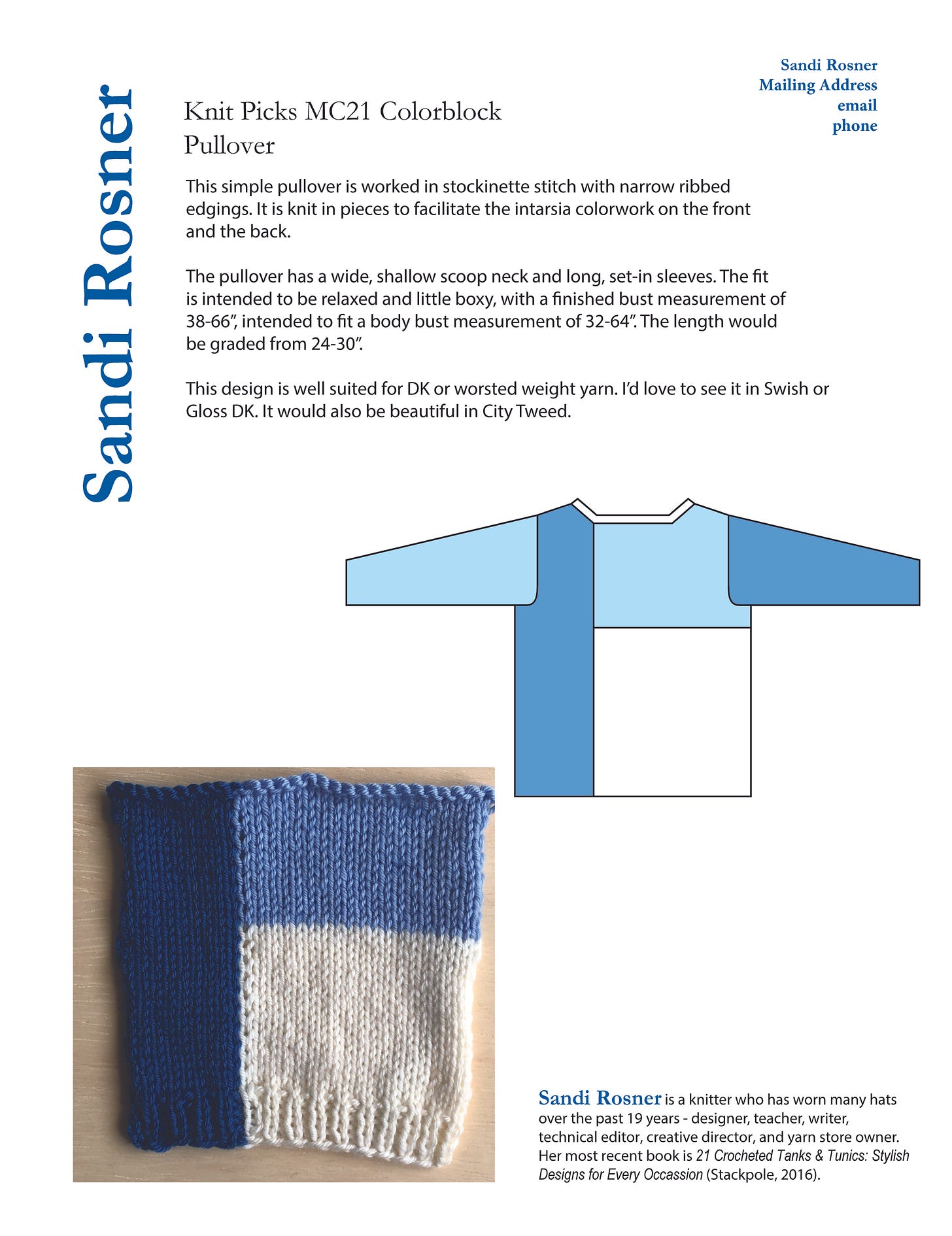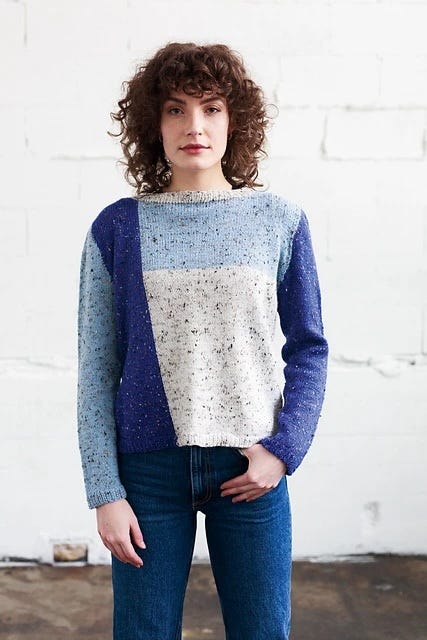I'm franticly knitting away on a couple of design commissions. As I've mentioned to you before, I can't show you any sneak peeks. The yarn companies reserve the right to announce new designs, and I'm contractually prohibited from stealing their thunder.

A couple of weeks ago, subscriber
suggested I write about how design commissions work. I've seen this process from all angles (magazine editor, yarn company creative director, freelance designer) and I'm happy to shed some light. I'll be using a design from way back in 2020 as an example.The Call for Submissions
Yarn companies and magazines (online magazines and the few remaining print magazines) send out calls for submissions several times a year. These calls vary. Sometimes they are a pdf or link to a Pinterest board with a description of the collection themes and a series of fairly abstract inspirational images. Other times they are quite specific, outlining not only themes, but the types of projects they are looking for, the color palette, and the yarns they want to feature.
Tip: You can often find links to current calls for submissions on the publisher's website (like here). You can also ask to be added to the publisher's mailing list so you receive the calls for submission via email (like here).
Most of the time, designers will have four to six weeks to respond to a call for submissions. I usually find that I either immediately have some ideas pop up, or the call leaves me cold. For example, I recently received a call looking for whimsical holiday home dec designs. I don't decorate my home for the winter holidays and whimsy isn't really in my wheelhouse, so I did not respond to this call.
If a call sparks some interesting ideas, I let them percolate in my head for a few days, then start work on my submission.
The Submission
Different designers work differently. My process is what works for me, but I know many designers are much more methodical and devoted to documenting their ideas and inspirations than am I.
Once an idea has developed in my head to the point where I can envision the finished project, I dig in my stash for appropriate yarn and make a swatch. My swatches are usually 6 to 8 inches square—just enough to illustrate the fabric I'll be creating. A design with elaborate lace or cable patterns may require a much larger swatch.
After the swatch is complete, I prepare my proposal. Here is the proposal for a design which was commissioned by Knit Picks back in 2020.
Frankly, my proposals are pretty minimal. Preparing a proposal is work for which I may not be paid. I don't want to spend more time than is necessary to communicate my idea to the publisher. I use Adobe Illustrator to make what's called a "flat"—a simple line drawing of the garment. I talk about construction method, proposed sizing, and preferred yarns. I add a photo of the swatch. There is a brief bio to remind the publisher why they might want to work with me. And that's it.
Some designers submit much more elaborate proposals, with beautifully drawn fashion sketches, multiple swatches, and lots of detail. I think if you can convey your idea clearly and simply, without a lot of embellishment, you make the editor’s job easier.
I convert the Illustrator file to a pdf and send it off to the publisher. Then I wait. Note that I have not yet written the pattern or knit a sample. I'm not going to do that work unless the design is sold.
Decision Time
The publisher collects all responses to their call for submissions and reviews them, usually with an internal team. After making their selections, they send emails either accepting or rejecting the proposals.
The acceptance will often include notes on aspects of the design the publisher would like the designer to change. It will also include the design fee they are offering to pay and specifics about deadlines. Finally, it will specify the yarn and colors they have selected for the design.
As a designer, I'm always happy to receive an acceptance (they like me!), but I don't always agree to the terms being offered. Design changes are usually no problem for me. Sometimes I can't fit the proposed deadline into my schedule, or the design fee is too low. I don't hesitate to negotiate for more time, more money, or both. If the publisher and I can't agree on acceptable terms, that is not the end of our relationship. We might come to an agreement on the next project.
This is getting long, so I'm going to close with a photo of the sweater that resulted from this commission. It's called the Blocked Pullover, and you can find the pattern here.
If you'd like me to write about the next steps in the process, bringing the design from contract to completion, leave a comment and let me know.
With Gratitude for Alice Munro
Alice Munro, the Nobel Prize winning master of the short story, died this past Monday at the age of 92. You can read the obituary from the New York Times here. For a more personal remembrance, read Margaret Atwood’s piece about Alice Munro here.
I love short stories. It's a notoriously challenging form to write. There is no room in a short story for page after page of exposition or rambling backstory. The short story writer must convey character, setting, conflict, and narrative within the confines of about 100 pages or less (often much less). A great short story is fiction distilled and refined to its essence. It can hit you like an arrow to the heart.
Alice Munro sits at or near the top of anyone's list of the 20th century’s best short story writers. Her 14 published story collections are packed full of near-flawless gems. I can't choose a favorite from among her stories, but my favorite collection is Hateship, Friendship, Courtship, Loveship, Marriage1 from 2001. Munro's pinpoint focus on telling details and her unerring ability to get straight to the heart of the matter are on full display in this collection of nine stories.
For more recommended Munro, take a look at this article from the Times with suggested stories for readers new to her work. But fair warning: Reading Munro will change you.
As always, thank you for spending a little time with me this week. I know there is no limit to the writers available for you to read, and I appreciate your choosingme.
Continue the conversation: Do you want to hear more about how knitting designs become patterns available for sale? Or do you have a favorite Alice Munro story? Let me hear from you in the comments!
That link is a affiliate link to Bookshop.org, a non-profit which supports independent bookstores. If you make a purchase using that link, I’ll make a small comission at no additional cost to you.






With Vogue knitting, Knitters and other magazines going out of business, how is the market evolving. It is a very strange and difficult time for publishing.
Love the pullover. Thank you for sharing great information about how submissions work. I've never tried to negotiate terms so far. Obviously each collaboration works differently and sometimes I have had to play by the ear to make decisions that are new for me. For e.g. recently I was asked if I would sell a sample. It would be great to have some kind of forum to discuss standard industry practices.